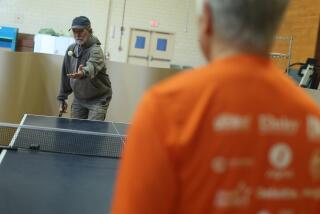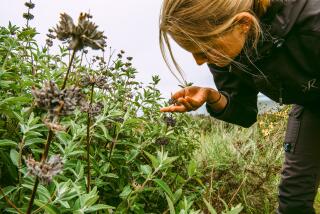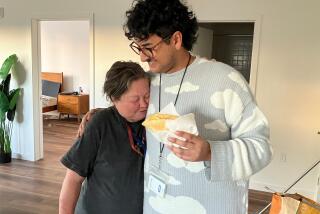Hospice Visitors Raise the Level of Personal Care
- Share via
During his lifetime, Fletcher Jackson has had many friends, but none like Susan Townsend.
His days at a Pasadena convalescent hospital begin and end with a phone call to Townsend, who visits him once or twice a week, occasionally bringing her husband and two children.
The rattan bookcase in his room is from Townsend’s home. The bulletin board she got him is covered with postcards from her recent trips. Sometimes, she surprises him with strawberry ice cream, his favorite. In return, Jackson grins happily.
During the 10 months that Townsend has been visiting Jackson, they have become close. Townsend helped Jackson write letters that reunited him with some East Coast relatives. And when his brother was hospitalized in South Carolina, she tracked him down so that the two could talk on the phone.
“She’s done a lot for me,” said Jackson, 78, a retired construction worker. “She’s made my life a whole lot brighter.”
Townsend, 51, shrugs off any accolades, saying she’s no better than other hospice volunteers.
“You just try to make them as comfortable as possible,” said the Pasadena homemaker.
Townsend volunteers for Hospice of Pasadena, which trains volunteers to visit frail elderly, seriously ill and terminally ill patients.
Volunteers also relieve family and friends who need a break from their caregiver duties. Often, they attend the patient’s funeral and provide ongoing support to the grieving family.
The volunteer operation does not provide medical care, but frequently works in conjunction with traditional hospices that employ physicians and nurses to care for dying patients.
Since 1983, Medicare has funded hospice care for terminally ill patients who are not receiving aggressive treatment and who have been given a prognosis of six months or less to live. After the first six months, doctors can extend Medicare-funded hospice care for patients who are continuing to decline.
In order for the medical hospice to be paid for its services, the federal government requires 5% of the patient’s care to be provided by volunteers.
When medical hospices run short of volunteers, they contact organizations such as Hospice of Pasadena. Jackson receives medical care from South Pasadena-based Hospice Cheer.
The volunteers “go way above what’s expected of them,” said Maureen Evans, a Hospice Cheer bereavement coordinator and volunteer, who assists with Hospice of Pasadena’s volunteer training. “They’re blessed with a gift. They’ve heard it and they’ve woken up to it. I wish there were more.”
In addition to training volunteers, the hospice provides free grief counseling and coordinates community presentations about giving care. The hospice operates on an annual budget of $600,000, which comes from donations, grants and fundraisers.
The 25-year-old hospice has 77 volunteers who range in age from their early 20s to their mid-80s and collectively speak 14 languages, including Spanish, Armenian, Mandarin, Cantonese and Creole. Many have lost a loved one themselves and want to reach out to patients and their families during a difficult, emotional time in their lives.
Volunteers are asked to spend a minimum of two hours a week with their patients, which includes visits and phone calls. However, most volunteers work an average of four to five hours a week.
The volunteers receive 16 hours of training on subjects such as the value of reminiscence, listening skills, family dynamics and the spiritual dimension of death and dying. After completing the training, about 10% decide not to continue.
“Those who drop out are usually still in some stage of bereavement themselves,” said Marilyn Boska, Hospice of Pasadena’s director of volunteer and community services. “They want to give, but they’re trying to go into this too soon.”
Penny Anderson of Burbank started volunteering more than a year ago after her daughter, Gina, underwent successful treatment for a malignant brain tumor. She felt the need to return some of the kindness her family received during Gina’s yearlong ordeal, which included five weeks in intensive care.
After accompanying her mother to a volunteer training class, Gina decided to help out, too.
“I got hooked right from the beginning,” said Gina, 30. “I was ill for such a short period that, had it gone on longer, I don’t know if [friends and visitors] would have been able to keep it up. Their lives go on. I wanted to be able to give support to someone who didn’t have that.”
Gina’s empathy for her patients is genuine.
“I see her connect on a level that is truly glorious,” said Penny Anderson. “Sometimes it’s wordless.”
The mother-daughter volunteer team only knew their second patient for seven weeks, but they said it seemed like a lifetime.
Initially skeptical of volunteers coming to her home, Felicia Murphy, 40, quickly warmed to Penny and Gina Anderson. They helped Murphy, who battled ovarian cancer for 7 1/2 years, in a variety of ways, including changing her bed, cooking her meals and taking her to doctors’ appointments.
“They did it in a very beautiful way. They laughed and told stories to each other.... It was a magical matching of the personalities,” said Murphy’s mother, Jane D. Murphy, a marriage and family therapist.
While some pairings are a perfect match, at other times the volunteer needs patience and creativity.
After several visits to an elderly cancer patient, volunteer Anton Deszily was getting desperate. Despite many attempts to get the man to open up, the patient would just watch television, exchanging only a few words before dozing off.
After discovering the patient had been a milkman, Deszily offered to take him for a drive down memory lane.
The following week, Deszily drove the man past houses along his old route. Suddenly, the man became talkative, recounting stories of his former customers.
“He was so wide awake, it wasn’t even funny,” said Deszily.
Being around terminally ill people puts life in perspective, said the native Hungarian, who has been a hospice volunteer since 1991.
“You don’t complain about little things when you see what other people are coping with,” Deszily said.
The relationship between patient and volunteer is often very special. Townsend and Jackson quickly formed a bond that has grown stronger during the last 10 months.
“We’ve had an extra long time together, so you learn a lot about each other,” she said. “We’re good friends.”
More to Read
Sign up for Essential California
The most important California stories and recommendations in your inbox every morning.
You may occasionally receive promotional content from the Los Angeles Times.










